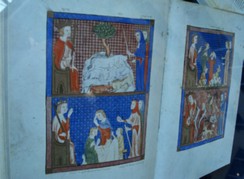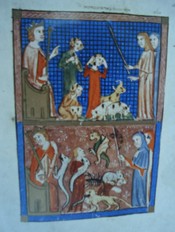The Sarajevo Haggadah
Saving the books from German Nazis in Croatia during WW2© by Darko Zubrinic, Zagreb (1995)
HAGGADAH is the Jewish book of rites, a collection of biblical stories, prayers and psalms related to Pesah, important Jewish holiday. It is named after an ancient Jewish prophet Haggai (around 520 BC). One of the most valuable such books in the world is the Sarajevo Hagaddah, written around 1314 in Spain. Unique by its extraordinarily rich illuminations, it came to present Bosnia and Herzegovina by the end of 15th century with Jewish Sephardic settlers, exiled from Spain in 1492. The value of this book of rare beauty is estimated by international experts to 700 million USD (1991). Since 1894 it is in possession of the Sarajevo Museum (Archeological Museum, Zemaljski muzej, founded by Sarajevo Croats in 1888). Kept with extreme care in a steel box, very few people had opportunity to see it.
The book had very turbulant history. Here we would like to describe how it had been saved during WW2 from the Nazi Germans. At that time (1941-1945) Sarajevo belonged to Independent State of Croatia (NDH), and director of the Sarajevo Museum was JOZO PETRICEVIC, a Croat. When German troups entered Sarajevo in April 1941, the Museum was visited by a German general Fortner, who ordered to bring Haggadah immediately.
- But mister general, - said Petricevic - one of your
colonels came yesterday and carried off the book.
- What was the name of the colonel? - asked the suspicious
general.
- We were not allowed to ask his name. - answered Petricevic
recourcefully.
The German general, whose intention was to take the book by force, ordered to search the Museum. The Haggadah was already hidden by Petricevic and his colleagues. Of course, Petricevic risked his life during the whole WW2 period, hiding the book from the eyes of German officers. It is not excluded that Petricevic collaborated with local Sarajevo NDH officials in doing so.
It is a great pity that in 1941 the Germans managed to carry off invaluable books of "Pinkes" from the Archives of the Jewish community of Sarajevo. "Pinkes" is the name of the collection of historical annals of the Sephardic community in Sarajevo covering the period of several centuries.
The German Gestapo also confiscated the annals ("Pinkes") of the Jewish Sephardic community in Dubrovnik, covering the period since 1600, which represents irreparable loss for the Jewish and Croatian culture.
According to personal information of professor
Marko Oreskovic, director of the National Library in Zagreb
in the period of 1944-1945 (NDH period), German officials
had intention to take valuable books from NDH to
Germany, which he managed to save.
Namely, owing to this danger the Croatian Ministry of Education gave
an order to bring books from Jews and Serbs to the National
Library in Zagreb. As an example, the Library of the Serbian
Patriarchy in Srijemski Karlovci (now in new Yugoslavia) was
saved from German Nazis during WW2. In 1945 the saved books
and works of art were returned to the partiarchy, and the
efforts of prof. Oreskovic were commended by the communist
officials. Also, risking his life, prof. Oreskovic did not
allow the Germans to install their anit-aircraft guns on the
roof of the Library, since otherwise there was a danger that
the Library could be bombed by the Allies. He also witnesses
about Mara Cvijanovic, an excellent administrator in the
Library during the NDH period, whose nationality was
Serbian. See Marulic III, Zagreb, 1999, pp 606-609.
Professor Oreskovic was a student of academician
Stjepan Ivsic, who recommended him for the position of
director of National Library in 1943. His predecessor on
this position was professor Mate Tentor, whose book
Povijest pisama (History of Scripts) was cited in a
monograph written by a famous English palaeographer David
Diringer. It is interesting that Diringer indicates in his
very selective bibliography that Tentor's book was written -
in Croatian.
For more details about the Sarajevo Haggadah see
Ljubica Stefan: Presucivani spasavatelj Hagade (in Croatian), Hrvatsko Slovo, 12 ozujka 1999.


